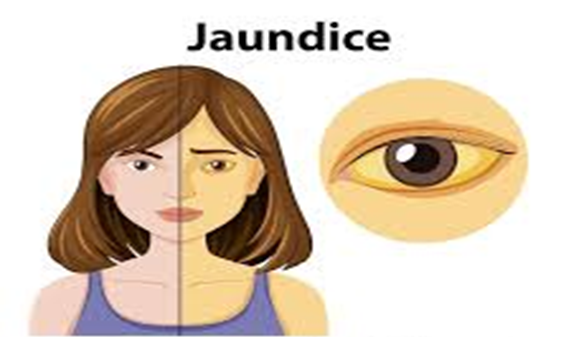A nurse is assessing a 64-year-old African-American client who has jaundice. The patient has a past medical history of alcoholism and liver cirrhosis. Which of the following areas is the most reliable for the nurse to inspect for jaundice?

Conjunctiva
Sclera of the eye
Back of the neck
Palms of the hands
The Correct Answer is B
Choice A Reason:
The conjunctiva can sometimes appear yellow in individuals with jaundice; however, it is not the most reliable area to inspect for jaundice. The conjunctiva may be affected by other factors such as environmental irritants or infections, which can alter its appearance.
Choice B Reason:
The sclera of the eye is the most reliable area to inspect for jaundice. The yellowing of the sclera, also known as scleral icterus, is a key indicator of jaundice. The sclera's white background provides a clear contrast, making any yellow discoloration more noticeable. This is particularly true in darker-skinned individuals, where skin changes may be less apparent.
Choice C Reason:
The back of the neck is not a reliable area to inspect for jaundice. Skin pigmentation and lighting can affect the visibility of yellowing, making it an unreliable indicator. Additionally, the back of the neck may have other skin changes unrelated to jaundice that could confuse the assessment.
Choice D Reason:
The palms of the hands are not the most reliable area to inspect for jaundice. While the palms may show yellowing, they are subject to various external factors such as manual labor or exposure to substances that can affect their color. Moreover, the palms' skin may be thicker and less transparent, making subtle changes in color more difficult to detect.
Nursing Test Bank
Naxlex Comprehensive Predictor Exams
Related Questions
Correct Answer is B
Explanation
Choice A Reason:
Rhinitis medicamentosa, also known as rebound congestion, is a condition of nasal congestion without other cold or allergy symptoms, typically caused by the overuse of nasal decongestant sprays. It does not usually present with chronic headaches or tenderness over the sinuses, which are more indicative of sinusitis.
Choice B Reason:
Acute bacterial sinusitis is likely the correct diagnosis in this scenario. It often follows a viral upper respiratory infection and presents with symptoms such as thick, discolored nasal mucus, decreased sense of smell, and facial pain or tenderness over the affected sinuses. The chronic headache and noted tenderness upon palpation over the sinuses in the client are consistent with this condition.
Choice C Reason:
Epistaxis, or nosebleed, is bleeding from the nose that can be caused by various factors, including trauma, medication, or environmental conditions. While it can be a symptom of other nasal conditions, it is not typically associated with chronic headaches or sinus tenderness following an upper respiratory infection.
Choice D Reason:
Allergic rhinitis is an allergic reaction to allergens such as pollen, dust, or pet dander, causing symptoms like sneezing, runny nose, itchy eyes, and sometimes headaches. However, the chronic headache and sinus tenderness described by the client after an infection are more suggestive of sinusitis rather than allergic rhinitis.
Correct Answer is A
Explanation
Choice A reason:
The primary purpose of health assessment is to collect, analyze, and interpret data to identify the patient’s health status and needs, as well as to develop and implement appropriate nursing interventions to address these needs. It is a systematic process that is fundamental in promoting the health and well-being of patients. This involves a comprehensive evaluation of the patient's physical, psychological, and social health. Gathering this information is crucial for creating a care plan that addresses the individual needs of the client.
Choice B reason:
While health assessments can aid physicians in diagnosing illness, they are not solely for the purpose of diagnosis without further testing. Health assessments may indicate the need for additional tests to confirm a diagnosis. The nurse's role includes supporting the diagnostic process, but it is not the primary purpose of health assessment.
Choice C reason:
Health assessments are not meant to be subjective or based on the nurse's personal views and beliefs. The assessments are conducted to objectively determine the health status of a client, which then informs evidence-based practice and care planning. Personal biases should not influence the management of a client's illness.
Choice D reason:
Making judgments about a client's lifestyle and behaviors is not the primary purpose of health assessment. While lifestyle and behaviors may be assessed as part of understanding the client's overall health status, the goal is not to judge but to understand how these factors may impact the client's health and to provide education and support for healthy changes if needed.
Whether you are a student looking to ace your exams or a practicing nurse seeking to enhance your expertise , our nursing education contents will empower you with the confidence and competence to make a difference in the lives of patients and become a respected leader in the healthcare field.
Visit Naxlex, invest in your future and unlock endless possibilities with our unparalleled nursing education contents today
Report Wrong Answer on the Current Question
Do you disagree with the answer? If yes, what is your expected answer? Explain.
Kindly be descriptive with the issue you are facing.
